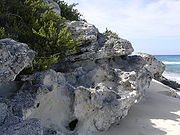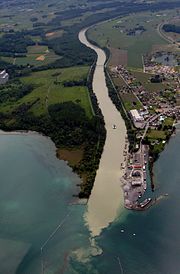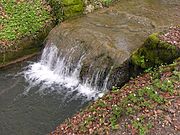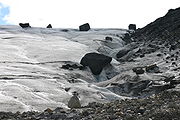
Sediment
Background to the schools Wikipedia
SOS Children made this Wikipedia selection alongside other schools resources. Sponsor a child to make a real difference.
Sediment is any particulate matter that can be transported by fluid flow and which eventually is deposited as a layer of solid particles on the bed or bottom of a body of water or other liquid. Sedimentation is the deposition by settling of a suspended material.
Sediments are also transported by wind ( aeolian processes) and glaciers. Desert sand dunes and loess are examples of aeolian transport and deposition. Glacial moraine deposits and till are ice transported sediments. Simple gravitational collapse also creates sediments such as talus and mountainslide deposits as well as karst collapse features. Each sediment type has different settling velocities, depending on size, volume, density, and shape.
Seas, oceans, and lakes accumulate sediment over time. These materials can be terrestrial (deposited on the land) or marine (deposited in the ocean); terrigenous deposits originate on land, but may be deposited in either terrestrial, marine, or lacustrine (lake) environments. Deposited sediments are the source of sedimentary rocks, which can contain fossils of the inhabitants of the body of water that were, upon death, covered by accumulating sediment. Lake bed sediments that have not solidified into rock can be used to determine past climatic conditions.
Sediment transport
See also: Sediment transport
Rivers and streams
Sediment moves in a variety of ways, depending on a balance between the upwards velocity and the settling velocity on the particles in the bed. If the upwards velocity is greater than the settling velocity, sediment will be transported downstream as suspended load. As there will always be a range of different particle sizes in the flow, some will have sufficiently large diameters that they settle on the river or stream bed, but still move downstream. This is known as bed load and the particles are transported via such mechanisms as saltation (jumping up into the flow, being transported a short distance then settling again), rolling and sliding. Saltation marks are often preserved in solid rocks and can be used to estimate the flow rate of the rivers that originally deposited the sediments.
The overall balance between sediment in transport and sediment being deposited on the bed is given by the Exner equation. This equation is important in that changes in flow depth and slope (see: depth-slope product) will change the basal shear stress, thus causing local areas of erosion and deposition. More large-scale changes such as dam emplacement and removal and sea-level variation change Base level and cause the river to either pool (and deposit its entire load) or rapidly erode into its underlying substrate.
Early applications of mathematical modeling of sediment transport in riverine systems were observed in the late 1970s. One such application was conducted by Santa Cruz County for the San Lorenzo River to study erosion from surface runoff and the resulting turbidity and bedload transport to downstream reaches. This work was used to analyze effects of land use practices in this drainage basin.
One of the main causes of riverine sediment load siltation stems from slash and burn treatment of tropical forests. When the ground surface is stripped of vegetation and then seared of all living organisms, the upper soils are vulnerable to both wind and water erosion. In a number of regions of the earth, entire sectors of a country have been rendered erosive; for example, on the Madagascar high central plateau, comprising approximately ten percent of that country's land area, virtually the entire landscape is sterile of vegetation, with gully erosive furrows typically in excess of 50 meters deep and one kilometer wide. Shifting cultivation is a farming system which sometimes incorporates the slash and burn method in some regions of the world. The resulting sediment load in rivers flowing to the west is ongoing, with most rivers a dark red brown colour, also leading to massive fish kills.
Surface runoff
Surface runoff water can pick up soil particles and transport them in overland flow for deposition at a lower land elevation or deliver that sediment to receiving waters. In this case the sediment is usually deemed to result from erosion. If the initial impact of rain droplets dislodges soil, the phenomenon is called splash erosion". If the effects are diffuse for a larger area and the velocity of moving runoff is responsible for sediment pickup, the effect is called "sheet erosion". If there are massive gouges in the earth from high velocity flow for uncovered soil, then "gully erosion" may result.
Fluvial bedforms
Any particle that is larger in diameter than approximately 0.7 mm will form visible topographic features on the river or stream bed. These are known as and include ripples, dunes, plane beds and antidunes. See bedforms for more detail. Again, bedforms are often preserved in sedimentary rocks and can be used to estimate the direction and magnitude of the depositing flow.
Key depositional environments
The major fluvial (river and stream) environments for deposition of sediments include:
- Deltas (arguably an intermediate environment between fluvial and marine)
- Point-bars
- Alluvial fans
- Braided rivers
- Oxbow lakes
- Levees
Shores and shallow seas
The second major environment where sediment may be suspended in a fluid is in seas and oceans. The sediment could consist of terrigenous material supplied by nearby rivers and streams or reworked marine sediment (e.g. sand). In the mid-ocean, living organisms are primarily responsible for the sediment accumulation, their shells sinking to the ocean floor upon death.
Marine bedforms
Marine environments also see the formation of bedforms, whose characteristics are influenced by the tides or currents.
Key depositional environments

The major areas for deposition of sediments in the marine environment include:
- Littoral sands (e.g. beach sands, runoff river sands, coastal bars and spits, largely clastic with little faunal content)
- The continental shelf ( silty clays, increasing marine faunal content).
- The shelf margin (low terrigenous supply, mostly calcareous faunal skeletons)
- The shelf slope (much more fine-grained silts and clays)
- Beds of estuaries with the resultant deposits called " bay mud".
One other depositional environment which is a mixture of fluvial and marine is the turbidite system, which is a major source of sediment to the deep sedimentary and abyssal basins as well as the deep oceanic trenches.



